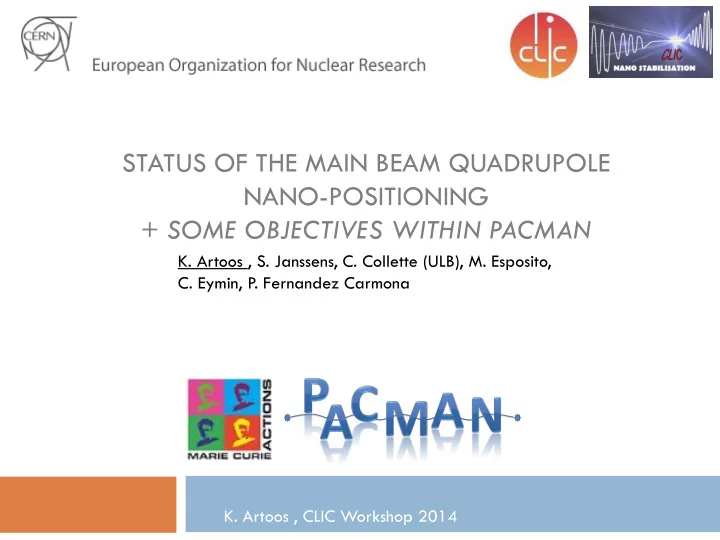

STATUS OF THE MAIN BEAM QUADRUPOLE NANO-POSITIONING + SOME OBJECTIVES WITHIN PACMAN K. Artoos , S. Janssens, C. Collette (ULB), M. Esposito, C. Eymin, P. Fernandez Carmona K. Artoos , CLIC Workshop 2014
Outline 2 Intro + Link to the PACMAN project Design + Construction of the type 1 stabilisation system First measurements 2014
Ground motion mitigation 3 BPM Quad Fidu Stabilisation Alignment Possible mitigation techniques: • Alignment f • B.P.M. + dipole correctors • B.P.M. + Nano positioning • Seismometers + Dipole correctors • Mechanical stabilization with seismometers
Compatibility of cascaded systems 4 Each system position should be unique above its resolution + known B Interaction ranges and accuracy P Conditions precision and accuracy cascaded systems M Conditions for > 6 d.o.f., Abbé errors + deformations Range Accuracy Precision/resolution (m) 10 -2 10 -3 10 -4 10 -5 10 -6 10 -7 10 -8 10 -9 10 -10 Alignment Magn. Fidu. BPM Nanopos. Stabilisation
Boundary conditions 5 Stiff actuating system Stiffness-Robustness K> 100 N/ μ m vertical+lateral Applied forces (water cooling, vacuum, power leads, cabling, interconnects, ventilation, acoustic pressure) Longitudinal transport locking -Transportability/Installation Successfully tested with x-y prototype Available space Integration in two beam module Ok, type 1 was not easy 620 mm beam height Accelerator environment High radiation No manpower Stray magnetic field Large temperature variations Tests in 2014
Concept for MBQ 6 • Inclined stiff piezo actuator pairs with flexural hinges (vertical + lateral motion) (four linked bars system) • X-y flexural guide to block roll + longitudinal d.o.f.+ increased lateral stiffness. Flexural pins
Concept for MBQ 7 A stiff but light Fixed frame around the mobile part, objective Natural frequencies > 100 Hz
Concept for MBQ 8 Central fixed part Magnet mounted with assembly tool
Concept for MBQ 9
Concept for MBQ 10
Concept for MBQ 11
Modal analysis Type 1 (simulation) soon to be tested 12 122 Hz 140 Hz 201 Hz 241 Hz
X-y positioning: Study precision, accuracy and resolution 13
Comparison sensors 14 Sensor Resolution Main + Main - Actuator sensor 0.15 nm No separate assembly Resolution No direct measurement of magnet movement Capacitive gauge 0.10 nm Gauge radiation hard Mounting tolerances Gain change w. Orthogonal coupling Interferometer 10 pm Accuracy at freq.> 10 Hz Cost Mounting tolerance Sensitive to air flow Orthogonal coupling Optical ruler 0.5*-1 nm Cost Rad hardness sensor 1% orthogonal coupling head not known Mounting tolerance Limited velocity Small temperature drift displacements Possible absolute sensor Seismometer (after integration) < pm at higher frequencies For cross calibration K.Artoos, Stabilisation WG , 21th February 2013
Displacement sensors 15 + actuator gauges, interferometer + seismometers (calibration)
First measurements Measured still on the assembly bench, not on the floor…. 16
First measurements 17 • (Noisy, especially Horizontal motion: laterally) (with gain correction for roll) • Good precision • Calibration is needed for a better accuracy
First measurements 18 Testing of the range
Concept demonstration actuator support with staged test benches 19 Collocated pair EUCARD deliverable Type 1 Seismometer FB max. gain +FF (FBFFV1mod): 7 % luminosity loss (no stabilisation 68 % loss) X-y proto
2014 20 Assemble type 4 , all parts ready (- assembly tool) T1 + T4 : combine stabilisation and alignment Extensive testing stabilisation, nano positioning + in combination. First “PACMAN tests”. Sensor out sourcing + testing Study alternatives for BDS actuating systems (decrease roll)
Spare slides 21
Nano positioning sensors 22 Technological innovation: ABSOLUTE optical encoders Faster measurements Heidenhain : 1nm resolution < 1000 CHF Renishaw: 1 nm resolution < 1000 CHF Smallest LSB can be used as quadrature …. 0.1 nm resolution is already possible
Integrated luminosity simulations 23 No stabilization 68% luminosity loss Seismometer FB maximum gain (V1) 13% Seismometer FB medium gain (V1mod) 6% (reduced peaks @ 0.1 and 75 Hz) Seis. FB max. gain +FF (FBFFV1mod) 7% Inertial ref. mass 1 Hz (V3mod) 11% Inertial ref. mass 1 Hz + HP filter (V3) 3% Commercial Custom Inertial Reference mass Seismometer Courtesy J. Snuverink, J. Pfingstner et al. Stef Janssens K.Artoos, Stabilisation WG , 21th February 2013
Resolution limitations Sensors 24 Stabilisation Limitations: 1. Thermal stability (*alignment) 2. EM stray fields Michelson 3. Sensor resolution Stabilised LASER (wavelength light) Expected maximum one order of magnitude improvement resolution in next decade (Without major technological innovation) Low freq. is where you can win the most
Nano positioning 25 « Nano-positioning» feasibility study Modify position quadrupole in between pulses (~ 5 ms) Range ± 5 μ m, increments 10 to 50 nm, precision ± 0.25 nm • Lateral and vertical • In addition/ alternative dipole correctors • Use to increase time to next realignment with cams
X-y Positioning: roll 26 -2 legs 3 d.o.f. > parasitic roll -Measured with 3-beam interferometer -~3 μ m lateral movement > ~7 μ rad rotation -Early simulations suggest~100 μ rad/0.5% luminosity loss (J. Pfingstner) 1&2 Parasitic roll S. Janssens, CLIC Workshop, January 2013
Roll simulations 27
Mass/Actuator Resolution/ Range/k/ Bandwidth 28 A Stress < depolarisation stress A ↑ 𝑊𝑝𝑚𝑣𝑛𝑓 ↑ 𝐷 𝑞𝑨𝑢 ↑ For same Range: P ↑ Resolution ↓ 𝑙 𝑏𝑑𝑢𝑣𝑏𝑢𝑝𝑠 𝑔 0 𝜕 = • 𝑛 𝑚𝑝𝑏𝑒 Bandwidth is limited by • Actuator slew rate Remark about load compensating springs: Amplitude Force Range Frequency Load compensation reduces range + bandwidth Improves resolution *
Recommend
More recommend